Last updated: April 7, 2025
Article
Podcast 067: Preserving Henry Ford’s Legacy: Henry Ford Museum in Dearborn, MI
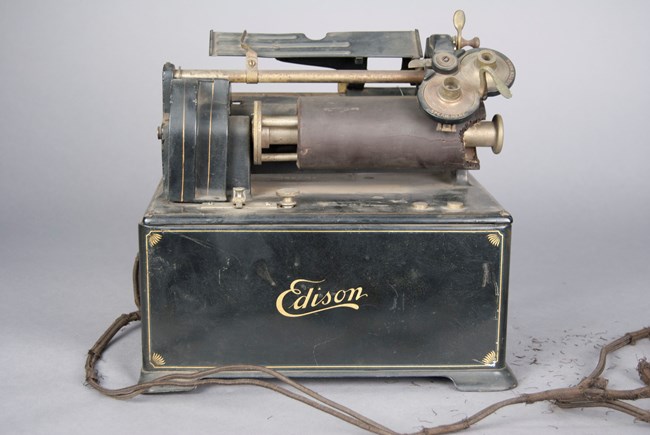
The Henry Ford Museum
Collections Specialist, Julie Dzurnak
Alex Beard: Hi. My name is Alex Beard. I’m here recording today at the Henry Ford Museum in Dearborn, Michigan, and I’m with a couple members of the Conservation and Collections Management team. First, I’m going to be talking to Collections Specialist, Julie Dzurnak.
Julie Dzurnak: Here in the museum when you look around, you can see a lot of different artifacts that we have on exhibit, such as the Rosa Parks bus. We have the chair that Lincoln was shot in, but most of the objects that we have you don’t actually see on the museum floor, although we do have a large percentage here.
Julie Dzurnak: They’re in off-site storage locations. What was hired on to do here was help with the re-housing and relocation of a majority of those collections from one of our storage facilities to a new storage site a little bit closer, in much better conditions than we currently have. Oftentimes, the need for the collections will outweigh the resources that a museum has in terms of funding or even workforce.
Julie Dzurnak: Basically what my job entails is re-housing objects. This can be anything from toasters to baby carriages to auto parts, anything really. We’re re-housing them in safer storage conditions, just in smaller boxes with the proper packaging to make sure that they can withstand the move, and then also that they’ll be safe and properly stored for years to come, which is kind of preventative conservation, making sure that the conditions are good for the objects now will ensure that they last longer into the future. That way our conservators will have not as hard of a job to do.
Alex Beard: Do you work closely with the Registrar’s Department and Conservation Department? Could you tell us a little bit about that?
Julie Dzurnak: Yeah. It definitely is a team effort between all of the departments. Registrars are really responsible for maintaining the records of the object, and then conservators, too, are constantly working with them to make sure that we as collections managers are making the right decisions in terms of different materials to use when packing objects, which kind of goes with collections management too.
Julie Dzurnak: Just taking steps to ensure the well-being of the objects in the future. Especially with a collection like the one that the Henry Ford has, there’s a lot of different materials that we see.
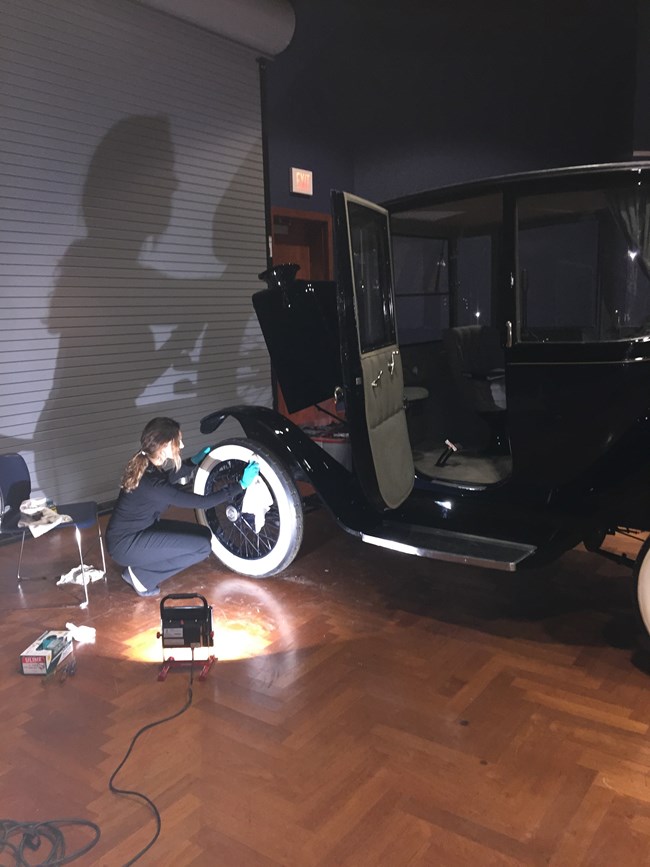
The Henry Ford Museum
Julie Dzurnak: It’s a huge, diverse collection, so we have to make sure that we’re working with the conservators. I think it’s really interesting to see different things that the conservation labs are working on, whether its textiles or things related to the IMLS Communications Grant.
Julie Dzurnak: But then also, too, I think it’s been really interesting learning how to move large objects, which is part of the move from off-site storage facility. We work closely with the exhibits team to get things like automobiles onto the museum floor. I will definitely say that has been a learning experience, and often entails a lot of all hands on deck kind of mentalities.
Alex Beard: I bet you have some stories for us.
Size of Vehicle Artifacts
Julie Dzurnak: Yeah, some of these older cars, they’re just extremely large. They’re boats of cars, so it might take about 5 or 6 guys to be pushing it, and also steering. You need someone to be in the car to steer. You need to be making sure that you’re not going to hit anything as you’re navigating through the museum with all the other objects on display.
Julie Dzurnak: Also, too, you have to make sure you get it through the doors, which our doors are 20 feet high in some cases to accommodate for the larger artifacts that we put on the floor here. The Allegheny train came through some of those doors. We also have airplanes and buses, just a lot of large artifacts here that it takes quite a crew to move sometimes.
Alex Beard: That’s really fascinating. That sounds like such a fun, unique place to work. Thanks so much, Julie, for talking to me today.
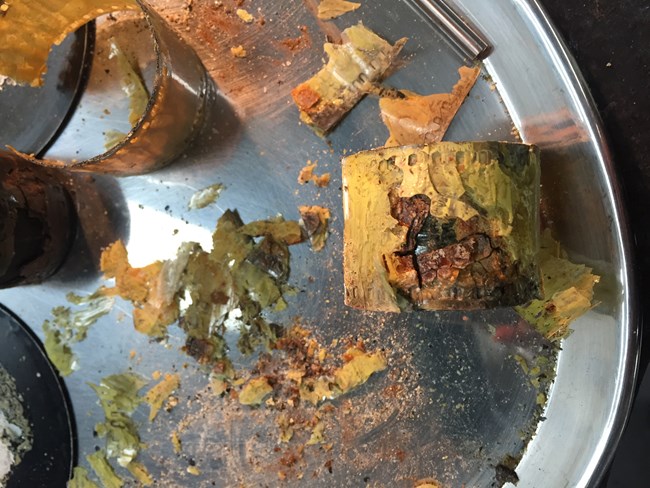
The Henry Ford Museum
Julie Dzurnak: It is.
Alex Beard: Right now, I’m here with Collections Specialist, Jake Hildebrandt, Conservation Specialist, Cayla Osgood, and Conservator, Jessica Lafrance-Hwang. They have been working on the IMLS Communications Grant-funded project for the past 2 years or so. Could you guys tell us a little bit about that project, and start by saying what IMLS stands for, please?
IMLS: Institute of Museum and Library Services
Jessica Lafrance-Hwang: IMLS stands for the Institute of Museum and Library Services. They’ve given us a grant to work on communications equipment from the collection over a 2-year period. As Julie mentioned, we will eventually be moving the collection from numerous storage buildings to one storage facility that’s closer to the museum. The objects in this IMLS grant are all coming out of a storage facility on-site that houses mixed collections, including the communications equipment. Our goal for this project was to catalog, conserve, photograph, publish online, and rehouse 1,000 objects from this collection. We passed the goal already, but we get to continue working for a few more months.
Cayla Osgood: So far in the grant, we have been working on televisions, radios, computers, recording equipment, typewriters, and cameras, and we just acquired the Apple One, which isn’t part of the grant, but was a fun acquisition.
Alex Beard: So, conservators. Could you guys tell us a little bit about some of the obstacles you guys face dealing with the IMLS artifacts. I would imagine it would be a little challenging dealing with some of them considering some sat in a storage facility untouched for half a century.
Jessica Lafrance-Hwang: It has been a challenge. One of our biggest challenges have been hazardous corrosion products, like cadmium and lead, that form because of just … Part of it is the way the objects are built, and then another factor is just how they were stored for so long.
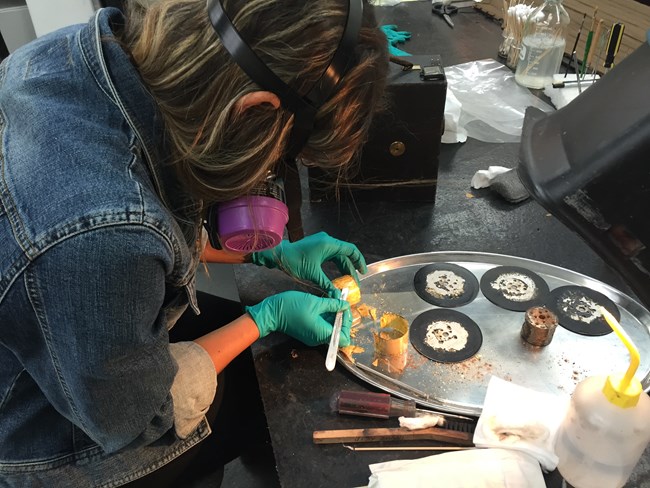
The Henry Ford Museum
Hazardous Materials Require Safety Precautions
Jessica Lafrance-Hwang: We’ve also had challenges with asbestos, which is normal to find in objects that would have had heat sources, and as well, we’ve had problems with cellulose nitrate, having been left inside cameras that were acquired and then put into storage. The cellulose nitrate degrades over time, and also causes degradation of everything around it.
Cayla Osgood: Some of our other issues on this grant have been mold, which, the storage facility that we have been pulling the communications objects out of had a mold problem in the past. We have taken extra precautions to make sure that we protect ourselves from the mold to avoid overexposure, and to prevent another outbreak from happening in the new storage facility. We have also encountered a lot of tape on objects, and the adhesive on the tape is extremely hard to remove, especially when it’s been on the object for half of a century. Another thing that we have encountered a lot of is objects that have no information with them. They have no tags.Cayla Osgood: That is a problem not only for us, but for the registrars and collections management departments, so we’re working on tracking down the information for those. Also, we have encountered a lot of grease on objects, but that is due to the nature of the objects themselves, but it’s quite a challenge to remove all of the grease.
Cayla Osgood: In order to protect ourselves and the other people in the lab, we make sure to clean the objects before we bring them into the museum. That way we don’t have spores create another outbreak in the museum or in our new storage facility. Since mold thrives in a warm and wet environment, we make sure that we aren’t putting ourselves at risk.
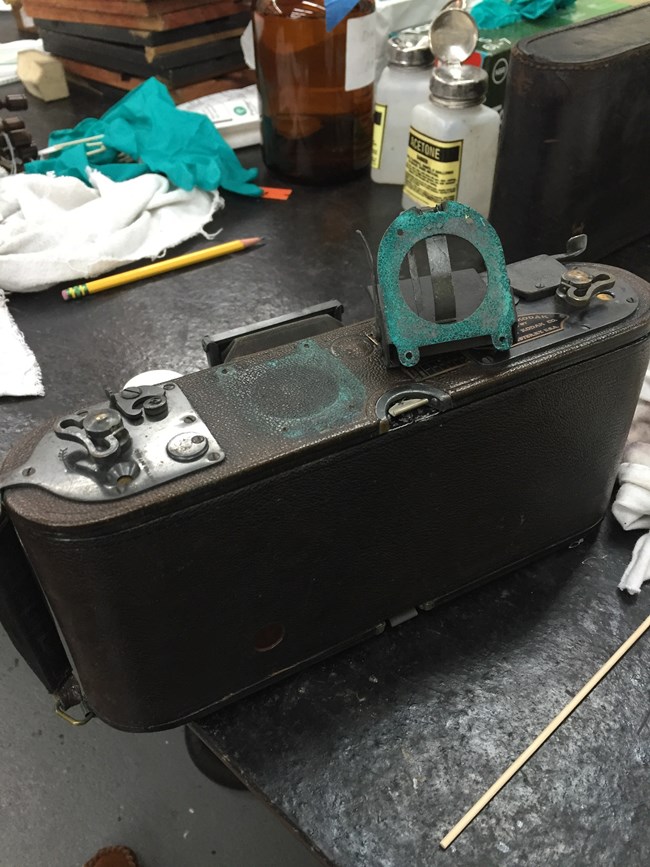
The Henry Ford Museum
Jessica Lafrance-Hwang: As you just heard, a lot of these challenges are a little bit hazardous to us, and also a lot of the general conservation work can be hazardous, just because of the amount of solvents and the amount of particulates that are created when you’re removing corrosion products and dust. We take a lot of safety precautions when we’re working. This includes wearing a half mask and the proper cartridges with your mask, but also running ventilation and disposing of hazardous materials properly.
Jessica Lafrance-Hwang: My piece of advice to people at home who may have objects of their own, is to treat them with care, keep them out of the light, keep them dry, keep them covered to avoid dust accumulation, and don’t over-clean them. If you really have something that you can’t figure out, or an object that’s in poor condition and you’re not sure how to handle it, definitely call your local conservator.
Jessica Lafrance-Hwang: There are conservators all across the country who would be more than happy to help you out, even just to answer your questions. You can also contact the conservation department at the Henry Ford for advice and treatment options, and they can also help you get in contact with somebody in your local area.
Alex Beard: When dealing with potentially hazardous artifacts or precious family heirlooms, it is always best to contact your local conservator or the head conservators at the Henry Ford Museum for treatment consultation.
Interdisciplinary & Interdepartmental Conservation
Jake Hildebrandt: One of the really interesting parts of this project was the inter-departmental nature of it. It’s a really good excuse to work with registrars, photography, certainly conservation is one of the big major players of it.
Jake Hildebrandt: But some of the stuff we’ve uncovered has been interesting stuff for the public, so we’ve been doing a little bit of talk with marketing and all that, so it’s really been a whole-institution project, which has been great for all of us to meet people and to see how all kinds of things work. A little bit about what I’m doing on the project, I’m sort of the last step on the pipeline, basically figuring out the best way to store these artifacts.
Jake Hildebrandt: Our plan is not real long-term for them to be in deep storage, anyway. Hopefully we’re getting our new storage building in 2 to 5 years or so, but we’re playing on the cautious side, planning for decades. We’re using Ethafoam and corrugated plastic, which is a lot like corrugated cardboard, but made out of a stable, long-term stable inert plastic, so it’s water-resistant. It’s very sturdy, so a lot of these artifacts are very heavy for the small size, so it’s good to have sturdy handles that they can be carried around in and everything should be protected mechanically and chemically, and from water.
Alex Beard: That’s great, Jake. Jessica mentioned earlier that the goal of the project was to stabilize and preserve at least 1,000 artifacts. How many boxes would you say you’ve made, and what do you think’s been the most difficult box to construct so far?
Jake Hildebrandt: A lot of them have been big enough that they just live on pallets with dust covers and things like that, so I haven’t made 1,000 boxes, but maybe 5 or 600. They’ve all been relatively similar in how to make them and pack them. The hard ones are the artifacts that have a lot of stuff sticking out, like rods and knobs and things. It’s a little bit harder to pad them out so that they don’t jab into the side of the box and that kind of thing. Where the really challenge comes is … The verb we’ve started using is Tetrising, basically fitting boxes into larger boxes. We have these big 4-foot cube pallet crates that the boxes I make go into, so it’s a real challenge of packing them efficiently.
Jake Hildebrandt: One of our earlier things was this computer system from the mid-’80s that had all these big, really heavy parts that were fragile. They all have glass picture tubes and all that, so trying to fit that into a reasonable number of pallets was strenuous physically and mentally, but it’s really satisfying when they all sync into the pallet neatly. One of the really interesting things for us with this project is that a lot of the artifacts we’re bringing in are not historically significant per se, although a lot of them were, but a lot of them are just mass collections that were done a long time ago, which was sort of Henry Ford’s MO, to get just truckloads of things.
Jake Hildebrandt: His original idea for a lot of the museum was to show a bunch of similar things in a row to display them evolutionarily, so that you could see the stylistic and engineering progress as it went. It was kind of a precursor to current open storage ideas, where there’s not too much curation basically. You look at all the things and you can see the difference on your own, which we were able to do a bit here and there as we worked, and it was really interesting.
Alex Beard: Now I’m speaking with Senior Objects Conservator, Clara Deck, and she’s here to shed some light a little bit on some of the interesting projects she’s worked on through the years, and her involvement in the IMLS Grant project.
Clara Deck: Yeah, I’ve been here for 25 years as a conservator, and I’ve worked on many great things, including moving our 1914 carousel, and reassembling the Dymaxion House inside the Henry Ford Museum was a 3-year project and an ongoing responsibility. But as a Senior Conservator in place so huge with about a quarter of a million 3-dimensional objects, ranging from thimble-sized objects to steam engines, it’s important for conservators to be multi-taskers, but also to understand the basics of risk management.
Clara Deck: Conservators in a big history museum need to understand what are the greatest risks to collections, and to address those first and foremost. We don’t want to be rearranging deck chairs on the Titanic, and working on a tiny little item when whole storage rooms full of materials might be in jeopardy.
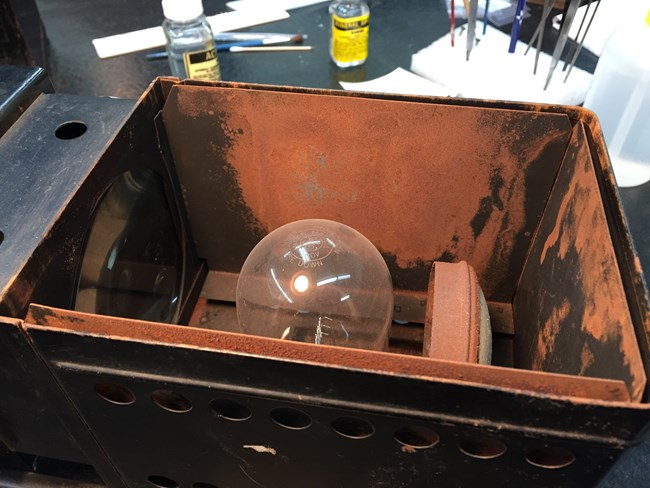
The Henry Ford Museum
IMLS Grant
Clara Deck: That was definitely the case with the IMLS Grant. It was actually initiated because I found mold in that huge storage facility, so it’s a warehouse sized building, and we found mold, and mold does spread everywhere, and so we realized that if we wanted to move the collections – we have a big plan to consolidate all the collections into one storage location very close to the museum – we needed to deal with that mold problem.
Clara Deck: Part of the grant application was to get the staffing we needed to start on a pilot project to clean that storage building. In my view, the IMLS project is really a mold remediation project, and all the benefits and the great staff that has come to us as part of the project are sort of icing on the cake.
Alex Beard: Thank you so much. That was great. I’m here with Paper Conservation Specialist, Brooke Adams. Could you tell us a little bit about what you’re doing at the Henry Ford and what your favorite project has been so far?
Brooke Adams: My favorite project that I’ve been working on is also a project that I’ve been working on with the IMLS team of conservators, and I’ve been working on the boxes that Spindizzy cars come in, and boxes of really everything that IMLS or a collector had held onto, so a lot of boxes.
Brooke Adams: I think I’ve gotten very good at repairing boxes and surface cleaning the paper that is found, and the cameras and the toy boxes. A lot of those also had little guarantees, instruction manuals. I like working with IMLS because I get exposure to all these toys and photographic processes that I’ve never been able to handle before. These are all way before my time.
Brooke Adams: That’s part of what I like in general about working in conservation. I love working with papers. One of my favorite exhibits I worked on here was the Abraham Lincoln 150th anniversary of his death. That was incredible. You never get to touch those things. I got to surface clean and mend one of the pamphlets for the theater show that he went to see the night he was murdered. That was really interesting. There are a lot of wood block engravings that they had for his memorial. I got to mat a lot of those.
Brooke Adams: Yeah, surface cleaning things, that’s normally what I do, flatten things, mend them with Japanese tissue, and archival adhesive. I did re-house 200 glass plate negatives of the Wright Brothers, one of their flights in France, but I did that with Minoo, the paper conservator.
Brooke Adams: We just brushed them off and had fun holding them up to the light to see what was on there. They were being re-housed for storage. They had been sitting in one of the storage areas for many years in the box that the donor had put them in, so an acidic cardboard box.
Brooke Adams: They were all piled together, touching one another, so Minoo and I were putting them in the little paper folders that they were supposed to be in so they could properly be in their own little folders, not touching anything. We brushed off the dust that they were on. We made sure that they weren’t flaking horribly.
Brooke Adams: If they were, she’d set it aside or if it was broken, because some of the plates were cracked, she would put it on board between more board to hold it all together so it was one cohesive piece for storage. I don’t think something like that could go on exhibit, really, because it would be damaged from all that light exposure.
Alex Beard: Well, thank you, Brooke. That was really interesting. That concludes our podcast here today at the Henry Ford. I just wanted to thank all of you guys one more time, and I look forward to speaking with each of you again in the future.
Read other Preservation Technology Podcast articles or learn more about the National Center for Preservation Technology and Training.
